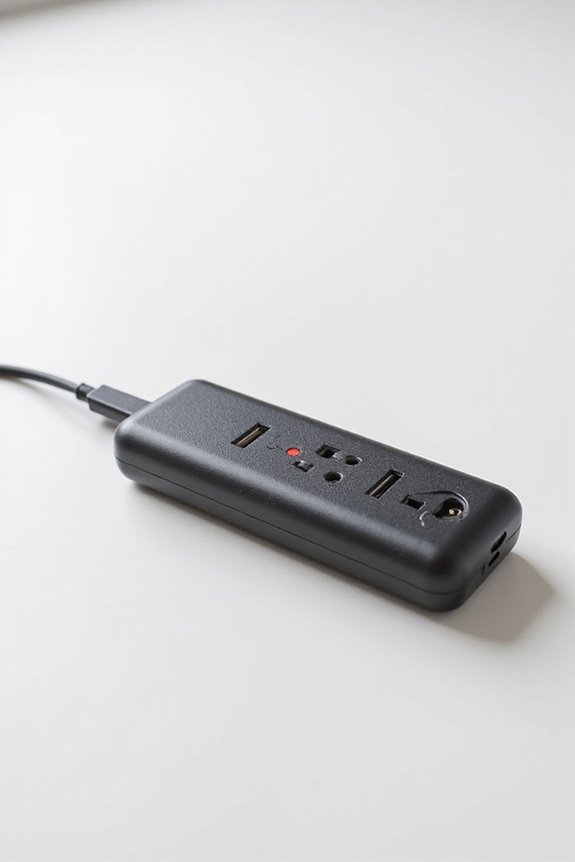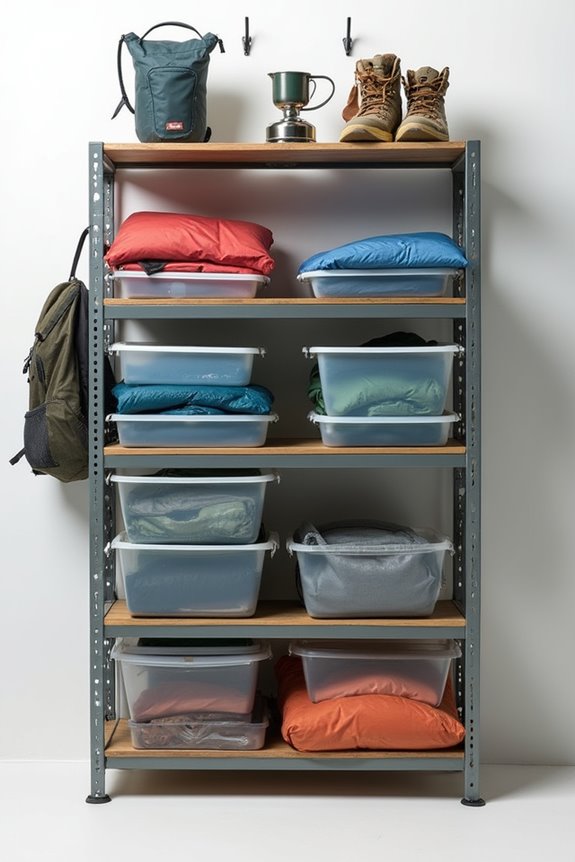Purifying water in the wilderness is essential for avoiding nasty illnesses. First, you can boil water; just get it to a rolling boil for at least one minute—three minutes if you’re up high. Chemical treatments like iodine and chlorine are handy, too, but be cautious with cloudy water. Filtration systems work wonders, turning murky streams into crisp, clean sips. If you stick around, you’ll discover even more nifty ways to keep your hydration game strong.
Key Takeaways
- Boil water for at least one minute (three minutes at higher elevations) to kill pathogens effectively.
- Use chemical treatments like iodine or chlorine for lightweight, quick purification, but avoid cloudy water with iodine.
- Employ filtration techniques such as pump or gravity filters to remove bacteria and protozoa from water sources.
- Consider advanced methods like distillation or solar stills for thorough purification, though they require more time.
- Always start with the cleanest water possible to enhance the effectiveness of any purification method you choose.
Understanding the Importance of Water Purification
Water, the lifeblood of survival, is often taken for granted until one finds themselves in the great outdoors, far from the comforts of home. In these wild settings, untreated water can become a risky gamble. Imagine sipping from a clear stream, blissfully unaware of lurking pathogens. Waterborne diseases, like giardiasis and dysentery, can turn a fun adventure into a nightmare. That’s why hydration strategies are essential; staying hydrated is not just about quenching thirst, but about maintaining energy and cognitive function. Inadequate or contaminated water can lead to serious health issues—no one wants to be that camper who can’t enjoy the view because they’re stuck in a tent, feeling miserable. Planning for safe drinking water is a must for any wilderness enthusiast!
Boiling Water: A Simple and Effective Method
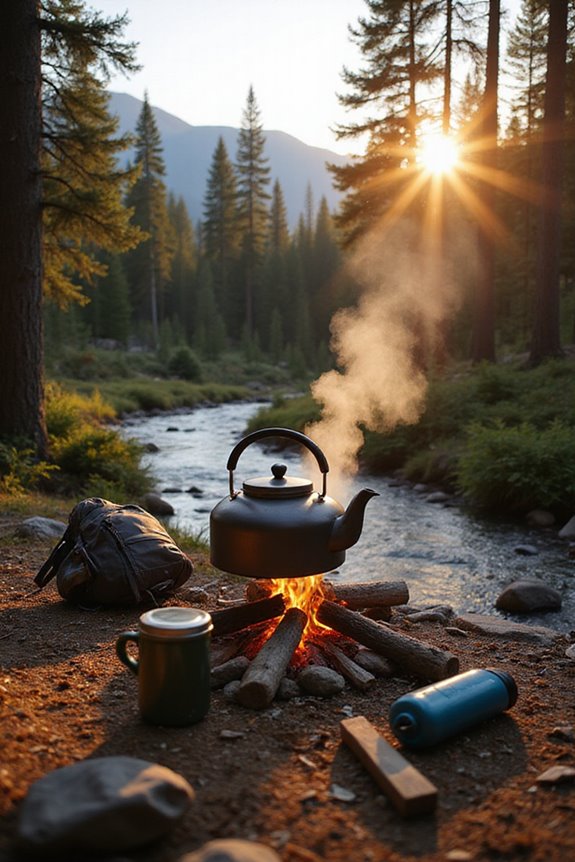
When venturing into the wilderness, boiling water emerges as a tried-and-true method for purification, transforming murky sources into safe hydration. This simple technique effectively kills bacteria, viruses, and parasites, making it a go-to choice for many adventurers. Using heat sources like camp stoves or open fires, one can bring water to a rolling boil for at least one minute at sea level. However, at higher elevations, extending that time to three minutes guarantees safety. While boiling does provide clean water, it may leave a flat taste—don’t worry, a bit of shaking or pouring between containers can help restore some freshness. Just remember, this method won’t remove chemical contaminants, so always start with the cleanest water possible!
Chemical Treatment: Using Iodine and Chlorine
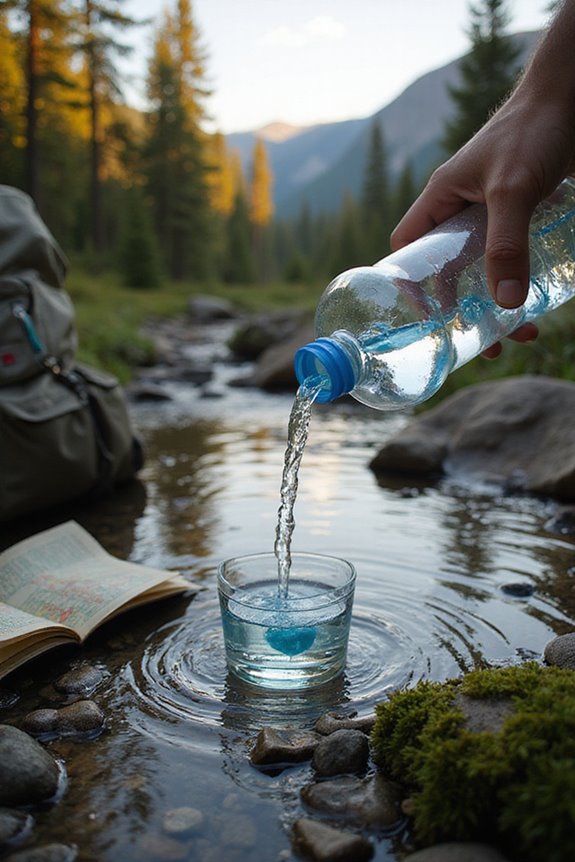
In the wild, adventurers often find themselves contemplating the best ways to guarantee their water is safe to drink, and chemical treatment with iodine and chlorine frequently comes to the rescue. Iodine, available in solutions, tablets, and crystals, boasts impressive iodine effectiveness against bacteria and viruses, though it’s not a fan of cloudy water—double the disinfection time in such cases. On the other hand, chlorine, commonly found as household bleach, offers convenience but comes with chlorine safety concerns, like potential carcinogenic byproducts. While both options are lightweight and inexpensive, iodine’s strong aftertaste can be a turn-off. Ultimately, these chemical treatments can keep adventurers hydrated, but caution is key—especially for long-term use!
Filtration Techniques for Clean Water
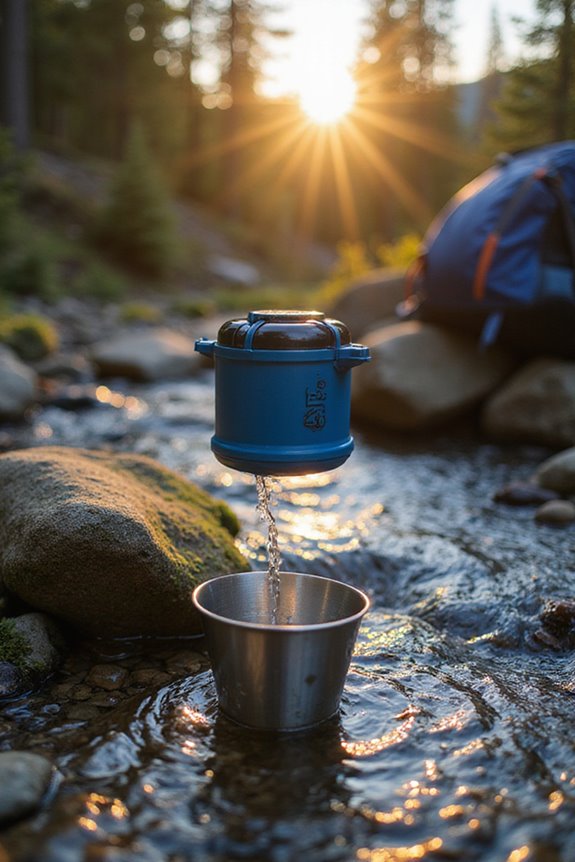
Setting off into the wild often leads adventurers on a quest for clean drinking water, and filtration techniques can be their trusty sidekick. Among the top choices are pump filters and gravity filtration systems. Pump filters, with their hand-operated magic, push water through fine filters, zapping away bacteria and protozoa. They shine in backcountry settings for their speed and reliability. On the other hand, gravity filters let nature do the work, using a dirty bag above a clean one; they’re perfect for groups and require minimal effort. However, keep an eye on clogging! Both methods have their quirks, but with a little maintenance, they transform murky streams into invigorating sips, making survival feel like a breeze.
Utilizing Ultraviolet Light for Water Purification
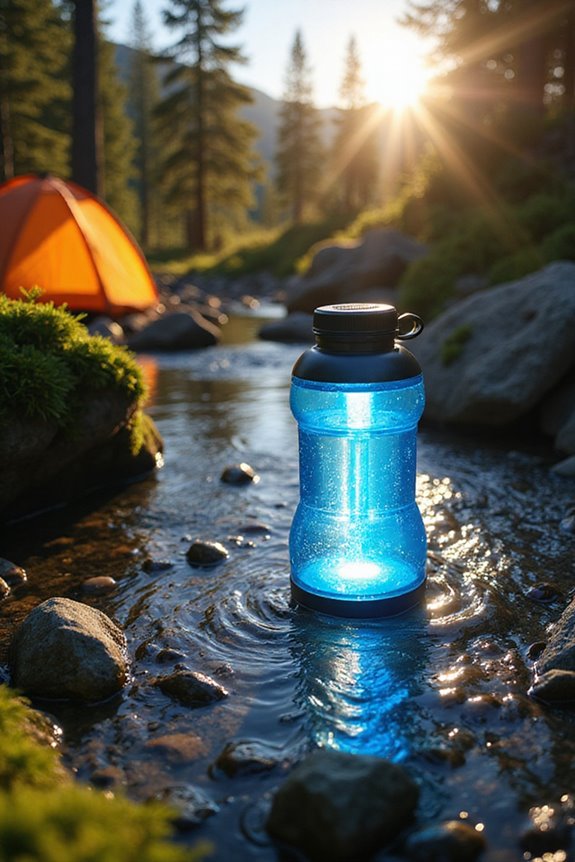
Ultraviolet (UV) light might just be the unsung hero of wilderness water purification, transforming murky puddles into crystal-clear hydration. With impressive UV effectiveness, this method can eliminate up to 99.99% of those nasty microorganisms lurking in your water. Not only is it chemical-free, making it safe to drink, but it also treats water in a flash—no waiting around! However, there’s a catch: it requires a reliable power source, which can be tricky when you’re out in the wild. Battery-operated options like the Katadyn Classic 3 or USB-powered devices can save the day. Just remember, while UV light does wonders, it won’t remove heavy metals or sediments, so some pre-filtration can boost its performance.
Distillation and Solar Stills: Advanced Techniques
When it comes to quenching thirst in the great outdoors, pure water is a non-negotiable. Advanced distillation techniques can make that happen, transforming murky water into something drinkable. By boiling contaminated water and capturing the steam, you’re left with a clean, revitalizing source. Imagine setting up a simple still using a pot, heat source, and a collection cup—an elegant solution in a survival situation. On the other hand, solar stills offer a passive approach. Picture a container buried in the ground, covered with plastic, with rocks creating a slope. Sunlight warms the water, evaporating it into steam, which then condenses and drips down. Both methods are effective, though solar stills take patience; good things come to those who wait!
Natural and Primitive Water Purification Methods
Natural and primitive water purification methods offer a fascinating glimpse into survival techniques that have stood the test of time. Imagine using natural ingredients like the Oregon grape plant or citric fruits, which pack antimicrobial properties to help clean your water. For those with a flair for DIY, primitive filters made from pebbles, sand, and cloth can remove larger particles before you boil the water. Hollowing out agave stalks to create these filters is a clever trick, especially in dry regions. Charcoal, with its impressive ability to enhance clarity and taste, becomes your best friend. By understanding these methods, adventurers can feel empowered, knowing they have the tools to make water safe, even in the wildest of places.
Combining Methods for Optimal Water Safety
Combining different water purification methods can be a game-changer for outdoor enthusiasts, guaranteeing safe hydration no matter where adventure leads. By utilizing method combinations, adventurers can adapt to various water sources and conditions, enhancing efficiency and reliability. For instance, pairing mechanical filters with UV treatment offers a robust purification strategy; the mechanical filter removes larger particles, while UV tackles pesky pathogens. This redundancy guarantees that water is not just drinkable, but safe. Additionally, using gravity filters for group settings while keeping a pump filter handy for quick access strikes a perfect balance between convenience and speed. Ultimately, these combinations extend equipment longevity and bolster overall safety, making every sip a worry-free experience in the wild.
Frequently Asked Questions
Can I Drink Water Directly From Lakes or Rivers?
Drinking directly from lakes or rivers is like dancing with danger; waterborne diseases lurk beneath the surface. Natural filtration may seem tempting, but unseen pathogens can turn a revitalizing sip into a perilous gamble for health.
How Can I Tell if Water Is Safe to Drink?
To determine if water is safe to drink, one should assess water quality by observing contamination indicators such as clarity, odor, taste, and proximity to pollution sources, ensuring the absence of visible impurities or unusual characteristics.
What Should I Do if I Have No Purification Methods?
What options remain when purification methods are absent? Employing natural filtration techniques, like using plants or settling water, alongside emergency strategies, can help guarantee access to safer drinking water in dire situations.
Are There Any Plants That Can Help Purify Water?
Various plants serve as natural filters for water purification. Cattails, water mint, and xylem from pine trees effectively remove contaminants, while Moringa seeds and other edible plants can clarify water through their inherent properties, promoting sustainable practices.
How to Store Purified Water for Long-Term Use?
To guarantee effective water storage, individuals should select appropriate purification containers, store them in cool, dark places, inspect regularly, and maintain a rotation schedule, preserving water quality for long-term use in various conditions.


